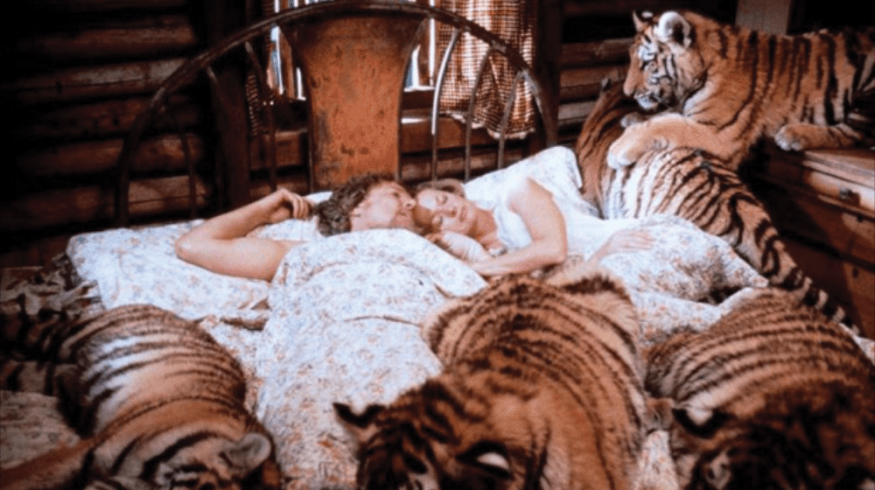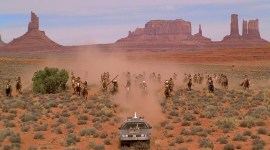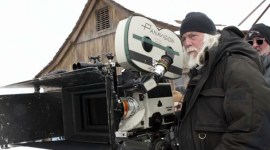
5 of the Most Dangerous Movie Sets in Film History
These productions faced perilous circumstances and devastating consequences in an attempt to overcome the odds of a dangerous set.
Top image via roarthemovie.com
Let’s take a look back at some of the high-risk set locations used in Hollywood productions of the past, and how those involved were affected.
Remember: Always make your cast and crew’s safety your main priority. For instance, avoid nuclear test sights.
The Viking (1931)
Video via Justin Oakey
The production of The Viking (1931) was actually relatively straightforward — until the end of principal photography when the filmmakers went in search of more environmental footage. Joining a seal-hunting expedition, director and producer Varick Frissell took some of his crew onboard a ship packed with ice-shattering explosives.
At some point, the explosives were compromised and unexpectedly detonated. Twenty-seven people were killed, including Frissell himself. Evidently, even those who take proper precautions are subject to freak accidents.
The Conqueror (1956)
Video via Aaron Lewis
One of the more controversial occurrences in terms of crew safety, the production of The Conquerer in 1956 ultimately led to the belated death of forty-six crew members due to widespread radiation poisoning. The film was shot near St. George, Utah — shortly downwind of a nuclear testing site. Due to false reassurances from the federal government at the time, the production was permitted over the course of a few weeks, during which time many developed cancer.
This fiasco is perhaps most infamous for possibly leading to the death of the classic American movie star, John Wayne. Wayne himself even argued his terminal lung cancer was a result of his smoking habits, but undoubtedly, many of the deaths over the ensuing years were attributable to consistent radiation exposure.
L’arche de Noe/Noah’s Ark (1928)
Video via Nachthymnen Carcharoth
Supposedly in an effort to properly follow up 1923’s The Ten Commandments, Darryl F. Zanuck and Michael Curtiz sought to recreate the story of Noah’s Ark. In a stubborn attempt to maximize realism, the production team chose to reenact a life-sized flood across the existing set, using over 600,000 gallons of water.
Unfortunately, the immense volume of water overwhelmed the crew and drowned three people. This later led to the implementation of more stunt safety regulations, and spurred accusations of carelessness for the crew’s safety. The tragic occurrence can actually be seen in the movie, which still used the footage in the final cut.
Roar (1981)
Video via Movieclips Film Festivals & Indie Films
Roar, a 1981 drama thriller, perhaps embraced realism too wholeheartedly in its production. Portraying a private zoo filled with over 100 wild animals, the film actually used a large number of legitimately dangerous wild animals on set.
As a result, over seventy of the cast and crew were severely injured. While no injury proved fatal, some crew members required hundreds of stitches to repair their various wounds, which included bites, maulings, broken bones, scalpings, and even cases of gangrene. Gruesome stories such as this one make modern CGI technology all the more appealing in faking on-screen wildlife.
The African Queen (1951)
This early-1950s adventure film was shot on location in the Congo and Uganda, Africa. At the time, shooting in Africa was far from common, and potentially due to lack of preparation, the cast and crew were exposed to harsh heat, poor nutrition, and widespread dysentery.
Video via Danios12345
Director John Huston and lead actor Humphrey Bogart were the only two to avoid illness, having only consumed imported whiskey throughout production instead of the contaminated water that caused the outbreak.
With modern visual effects, stricter safety regulations, more versatile transportation, and better available stunt equipment, movie production is fortunately much less treacherous now than it was throughout the 20th century.
What production environments have you found the most interesting? Let us know in the comments below.





